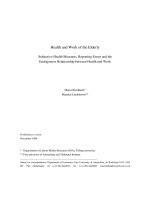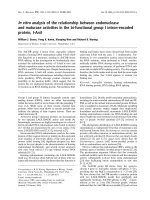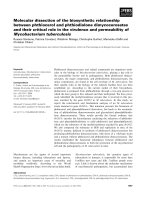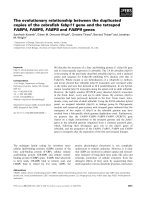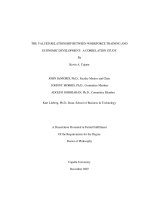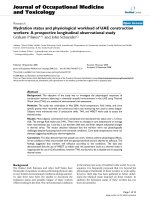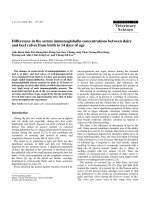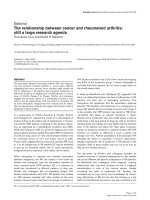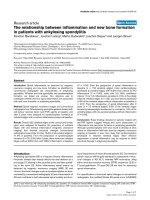The developmental relationship between language and motor performance from 3 to 5 years of age: A prospective longitudinal population study
Bạn đang xem bản rút gọn của tài liệu. Xem và tải ngay bản đầy đủ của tài liệu tại đây (484.43 KB, 10 trang )
Wang et al. BMC Psychology 2014, 2:34
/>
RESEARCH ARTICLE
Open Access
The developmental relationship between
language and motor performance from 3 to
5 years of age: a prospective longitudinal
population study
Mari V Wang1*, Ratib Lekhal2, Leif E Aaro1, Arne Holte1,3 and Synnve Schjolberg1
Abstract
Background: Previous research has found that language and motor skills are closely interrelated developmental
areas. This observation has led to questions about the specificity of these domains, and the nature of the
associations. In this study, we investigated the longitudinal relationship between language and gross and fine
motor performance from 3 to 5 years of age.
Methods: We tested the prediction across and within developmental domains using cross-lagged panel models. In
addition, estimates of specificity for each domain were calculated. Analyses were performed using parental reports
in a sample of 11 999 children from a prospective population study.
Results: Structural equation modelling revealed unique positive predictions from early language performance to
later fine and gross motor skills. Neither gross nor fine early motor skills uniquely predicted later language
performance. Both language and motor skills were stable from 3 to 5 years of age. Motor skills were more stable in
boys than in girls. Boys had lower scores than girls on fine motor performance, but gender differences in
cross-lagged associations between language and motor performance were non-significant. The variance specific to
language performance decreased from 68% to 46% in relation to fine motor skills and from 61% to 46% in relation
to gross motor skills from 3 to 5 years of age.
Conclusion: From 3 to 5 years of age the stability within each developmental area is high, and unique prediction
from one domain to the other is weak. These results implicate stable and correlated developmental pathways at
this age.
Keywords: Longitudinal, Language development, Motor development, Co-occurrence, MoBa
Background
Associations between language and motor skills have frequently been recognized. The developmental pathways
within each domain have been described in terms of rapid
changes, plateaus, as well as wide variability (Iverson 2010)
and common traits between domains have been found
(Hill 1998). Consequently, it has been difficult to disentangle the associations. Most previous research on this association has focused one-sidedly on motor profiles in children
* Correspondence:
1
Norwegian Institute of Public Health, Division of Mental Health, PO Box
4404, Nydalen, Oslo 0403, Norway
Full list of author information is available at the end of the article
with Specific Language Impairment (SLI) (Iverson and
Braddock 2011). A growing literature investigates the
interrelatedness of these developmental domains (Iverson
2010; Alcock and Krawczyk 2010). However, previous literature has been dominated by focus on one out of three
perspectives, rather than combining them. These three
perspectives are; 1) co-occurrence of difficulties, 2) stability of each domain across time, and 3) predictive power
from one domain to another across time. Most previous
studies are hampered by small sample sizes and are often
limited to clinical rather than population based samples,
mainly with Specific language impairment (SLI) or Developmental coordination disorder (DCD) (Hill 1998; Iverson
© 2014 Wang et al.; licensee BioMed Central Ltd. This is an Open Access article distributed under the terms of the Creative
Commons Attribution License ( which permits unrestricted use, distribution, and
reproduction in any medium, provided the original work is properly credited.
Wang et al. BMC Psychology 2014, 2:34
/>
and Braddock 2011). The purpose of the present study is
to gain new knowledge about the developmental relationship between language and motor performance across age
by combining the three perspectives described above in
one population based longitudinal study.
Several theories suggest links between motor development and specific aspects of language. The development
of gestures is the foremost example of this. Motor skills
influence the performance of gestures and studies have
shown that children with language delays very often have
a history of problems with gestures (Iverson and GoldinMeadow 2005; Zambrana et al. 2012a). Further, theories
of motor cognition, i.e. the notion that cognition is embedded in actions, suggest that perception and action
share common computational codes and underlying
neural architectures. This idea has been further developed in the study of mirror-neurons. It has been suggested that the mirror-neuron system is the basic neural
mechanism from which language has developed, and
that this system represents a strong link between language and action representation (Rizzolatti and Arbib
1998). Theories of embodied cognition argue that motor
resonance enhances language comprehension (Glenberg
and Kaschak 2002; Fischer and Zwaan 2008). These theories suggest that a broader developmental focus should
be employed both in research and in clinical practice
when investigating language and motor development.
Lately, researchers have questioned the specificity of
several developmental disorders (Goorhuis-Brouwer and
Wijnberg-Williams 1996; Snowling 2012). The frequent
overlap in symptoms across domains in developmental disorders as well as co-morbid diagnoses suggests less clear
distinction between clinical groups, especially in children,
than suggested by the diagnostic systems. When comparing children diagnosed with SLI or DCD to children with
no previously suspected disorder but with low standard
scores on language or motor skills, researchers found that
diagnosed children were more pervasive underachievers
on a large set of measures of developmental difficulties
additional to those corresponding to their diagnosis compared to those with low standard scores (Dyck and Piek
2010). This observation suggests that a broader developmental focus should be employed both in research and in
clinical practice.
Arguments have been proposed for grouping neurodevelopmental disorders together, such as language and
motor difficulties (Viholainen et al. 2006; Andrews et al.
2009). These disorders have several common features
(Rutter et al. 2006). They involve similar neural structures, and the development is characterized by a delay/
deviance rather than a remission or relapse (Jancke et al.
2007). Both of these disorders involve some degree of
cognitive impairment and have a marked male preponderance (Rutter et al. 2006). The genetic influences on
Page 2 of 10
individual differences in both domains are quite strong
(Fox et al. 1996; Spinath et al. 2004). Language difficulties
have been found to be highly hereditary (Spinath et al.
2004), and children with DCD have been found to have
neurological similarities to children with SLI, such as frequent rolandic spikes during sleep, suggesting a genetic
component (Scabar et al. 2006). More research is needed
on potential common genetic factors influencing development of both skills. Factors such as socio-economic
status (Payne et al. 1994), parental history of difficulties (Choudhury & Benasich 2003), or low birth weight
(Ribeiro et al. 2011) are known to influence both language
and motor skills. Thus, a child with slow development in
one of the domains will also be at risk of developmental
delay in the other.
Motor skills are often divided into gross and fine motor
skills. These are described as overlapping but different
(Hill 2001). Some studies have found that language skills
were associated only with gross and not fine motor skills
(Piek et al. 2008; Alcock and Krawczyk 2010), but an overall finding in literature concerning children with language
delays is that they are characterised by deficits in both
gross and fine motor skills (Hill 2001; Noterdaeme et al.
2002).
Studying at risk populations, two literature reviews have
concluded that contrary to the definition of SLI, people
with SLI may exhibit non-linguistic problems, such as impairments of gross and fine motor skills, and other functional problems (Hill 2001; Ullman and Pierpont 2005).
These findings are consistent with the results from a
meta-analysis of 14 clinical studies indicating an association between gross and fine motor delay and language
delay in children (Rechetinikov and Maitrat 2009). Comparing language profiles in children with DCD or SLI to
controls, results showed that the language profiles of children with either DCD or SLI are similar in the majority of
cases (Archibald and Alloway 2008). Also, research comparing motor profiles in children with SLI or DCD shows
that both groups are significantly lower than controls on
motor scores (Hill 1998). Few longitudinal studies have investigated developmental stability of language and motor
skills in general populations and results from these are inconsistent. However, the prospective longitudinal study
Early Language in Victoria Study (ELVS) (Reilly et al.
2009) showed that about half of late talkers catch up with
their peers, and a Finnish follow up study (Cantell et al.
2003) suggested that about half of children with motor
delay also catch up with their peers.
Symptoms of delayed or deviant language development
are related to a variety of different developmental outcomes such as ADHD, emotional and behavioural problems (Toppelberg and Shapiro 2000; Beitchman et al.
1996). Likewise, impaired motor function early in life
has been found to be a precursor of problems with
Wang et al. BMC Psychology 2014, 2:34
/>
language acquisition later on (AmielTison et al. 1996;
Cantell et al. 1994). Only a few studies have analysed the
relationship between language and motor development
longitudinally in community samples [Rechetinikov and
Maitrat 2009; Archibald and Alloway 2008]. Piek and
colleagues (Piek et al. 2008) studied the relationship of
early motor development and school age motor and cognitive development in 33 typically developing children.
They demonstrated that parent-reported scores on the
Ages and Stages Questionnaire (ASQ), measuring gross
motor skills during infancy, predicted later motor and
cognitive performance. The same association was not
found for fine motor skills (Piek et al. 2008). These results are consistent with the claims that early locomotor
experiences are an essential agent for developmental
change (Iverson 2010; Campos et al. 2000). However, the
association was limited to working memory and speed of
processing only and no association was found between
early gross motor skills and later verbal comprehension
(Campos et al. 2000). Another study of typical language
development in 102 children between 9 and 23 months
demonstrated large variability in both gross and fine
motor skills within each child across age, between the
children at each age level and across the developmental
domains (Darrah et al. 2003). Further, one study on
21 month old children (Alcock and Krawczyk 2010), investigated various motor skills, including oral movements,
in association with language production, comprehension,
and complexity. Results showed no residual associations
between gross and fine motor performance and measured
aspects of language development when controlling for oral
motor movements. These studies do not support a clear
predictive power from one domain to the other. Some
studies support language and motor skills as separate
domains while others suggest that motor skills are a
prerequisite for language development (Iverson 2010)
or that language predicts motor performance (Webster
et al. 2005).
In a previous study, we investigated the relationship between language and motor skills in typically developing
children from 18 months to 3 years of age (Wang et al.
2012). The study explored the association between language and motor skills (a distinction between gross and
fine motor skills was not made in this study) both concurrently and over time. The results showed that whereas
both skills were quite stable across age, early motor performance was an equally strong predictor of later language
performance as early language performance was. Early language performance did not predict later motor performance. At 18 months of age typically developing children
are in the beginning of rapid changes in development in
both language and motor performance (Darrah et al.
2003). At the age of 3, however, most children are able to
use and understand basic language, and are also able to
Page 3 of 10
move around and manipulate their physical environment
(Campos et al. 2000). It is therefore important to see
whether findings based on development from 18 months
to 3 years can be replicated at older ages.
In the present study we investigate the co-occurrence,
stability, and change in language and gross and fine
motor performance from 3 to 5 years of age in a large,
prospective longitudinal population study. This study is
based on the same sample as in our previous study. Our
main aim is to scrutinize the developmental relationship
between language and fine and gross motor performance
across age. More specifically we hypothesise; there are
cross-sectional correlations – language and motor performance are associated at both 3 and 5 years of age;
language and motor performance are both stable from 3
to 5 years of age, language performance at 3 years of age
predicts change in motor performance from 3 to 5 years
of age, and motor performance at 3 years of age predicts
change in language performance from 3 to 5 years of
age; there are gender differences – boys have poorer
skills in both language and motor domains, and we explore whether there are gender differences also in associations within and across domains over time. Finally, we
hypothesize that associations are similar for both gross
and fine motor performance. We also investigate the
specificity of each developmental domain.
Methods
Participants
The Norwegian Mother and Child Cohort Study (MoBa)
is a prospective population-based pregnancy cohort study
conducted by the Norwegian Institute of Public Health
(Magnus et al. 2006). Participants were recruited from all
over Norway from 1999–2008. A total of 38.5% of invited
women consented to participate. Informed written consent was obtained from all participants. The cohort now
includes 109 018 children. Follow-up is conducted by
questionnaires at regular intervals and by linkage to national health registries. The study was approved by the Regional Committee for Medical Research Ethics and the
Norwegian Data Inspectorate.
By June 2011 (data release version 5), 25 474 children
had turned 5 years of age and were thus eligible for the
present study. Data from three waves of data collection
were used; 17 weeks (Q1), 3 years (Q6), and 5 years
(Q5yr). We also used data from the Medical Birth Registry
of Norway (MBRN). For inclusion in this study, mothers
must have answered both the 3-year questionnaire and
the 5-year questionnaire. A total of 12 383 children satisfied this criterion. A total of 384 children were excluded
because of serious physical malformations, cerebral palsy,
Down’s syndrome, cleft palate or because of missing information on MBRN data. This gave a total number of 11
Wang et al. BMC Psychology 2014, 2:34
/>
999 participants (6 025 boys and 5 974 girls), corresponding to 47% of the eligible 5 year olds.
Demographic, health-, pregnancy- and birth-related
variables have previously been examined to investigate
potential self-selection bias in MoBa. Despite risk prevalence differences between the sample and the population, estimates of risk exposure and child developmental
outcomes were not significantly different when MoBa
participants were compared with the entire population
of Norwegian mothers (Nilsen et al. 2009).
Page 4 of 10
version used has been shown to have good construct validity (Strand et al. 2003). Information about the child’s age
at return of the questionnaires was included as covariate
at both 3 and 5 years.
Analyses
Language skills were assessed through maternal ratings
on selected items from the Ages and Stages Questionnaire (ASQ) (Squires et al. 1999) included in the MoBa
questionnaires. The ASQ has been validated in a Norwegian sample and found to be a successful diagnostic tool
for developmental difficulties (Richter and Janson 2007).
At 3 years, language was measured by six ASQ items,
and at 5 years, by seven ASQ items. All items had three
response categories (yes, sometimes, and not yet). Because the ASQ originally was intended as a screening
tool, most items had skewed distribution across response
categories. One item at 5 years singled out with 99.5%
responding “yes”, meaning that virtually all children
mastered the skill and was excluded (Question 3: Does
your child use four- and five- word sentences? For example, does your child say, “I want the car”?). More information on the items is presented in Additional file 1.
The relationships among latent variables were examined
with cross-lagged panel models. The models specified associations between language performance and motor performance at 3 years, auto-regression coefficients for each
of the factors, cross-lagged regression coefficients, and association between language performance and motor performance at 5 years (see Figures 1 and 2).
The structural equation model (SEM) analyses were
done using Mplus 6 (Muthén and Muthén 2007). Because
of the non-normal distribution of several variables in the
study, estimation procedures robust to deviations from
the normal distribution were utilized in all SEM analyses.
Weighted least square parameter estimates using a diagonal
weight matrix with standard errors and mean- and variance
adjusted chi-square tests, using a full weight matrix
(WLSMV) (Muthén and Muthén 2007) were applied.
Models including control for communication and motor
skills at 18 months of age were also estimated, but did not
alter the associations between language and motor skills
from 3 to 5 years of age in a noteworthy manner. Results
from analyses of this relationship from 18 months to 3 years
of age are presented elsewhere (Wang et al. 2012). Finally,
analyses were done to calculate the percentage of shared
and specific variance for the latent factors at 3 and 5 years.
Motor skills
Missing data
Fine and gross motor skills at 3 years were assessed
through maternal ratings on four items from the ASQ.
All items had three response categories (yes, sometimes,
and not yet). At 5 years motor skills were measured by
ten items (five items on gross and five on fine motor
skills) from Child Development Inventory (CDI) (Ireton
et al. 1977). At 5 years one item indicating gross motor
skills was excluded because of low factor loadings to the
latent variable (< .40) (question 5: Rides a two-wheeled
bike, with or without training wheels). The distribution
of responses to CDI-items was also skewed (See Additional
file 1 for further information).
WLSMV estimation works in four steps and uses a procedure for handling of missing with elements from maximum
Measures
Language skills
Fine motor
3 yrs
Fine motor
5 yrs
.00
.44***
Covariates
Information on the child’s APGAR scores five minutes
after birth, birth weight, and gestational age, was retrieved
from MBRN. Information on parents’ age, income, education and Norwegian language background was gathered
during pregnancy (Q1). Information about maternal psychological distress (anxiety and depression) was assessed
using a five-item short version of the Hopkins Symptom
Checklist-5 (SCL-5), at both 3 and 5 years. The short
.43***
.34***
.25***
Language
3 yrs
.79***
Language
5 yrs
Figure 1 Results from cross-lagged panel analysis. Correlations,
auto-regressive-, and cross, lagged correlations between language
and fine motor performance at 3 and 5 years of age.
Wang et al. BMC Psychology 2014, 2:34
/>
Gross motor
3 yrs
.56***
Page 5 of 10
Gross motor
5 yrs
-.02
.56***
The standard estimates for these items were fixed to be
equal.
Before including the latent variables in structural models,
correlation estimates between all latent variables, and the
observed variables for gross and fine motor skills at 3 years
(see Table 1), were computed independently of each other.
All correlations were highly significant.
.35***
Cross-lagged panel models
.12*
Language
3 yrs
.80***
Language
5 yrs
Figure 2 Results from cross-lagged panel analysis. Correlations,
auto-regressive-, and cross, lagged correlations between language
and gross motor performance at 3 and 5 years of age.
likelihood estimation and pairwise present deletion. This
procedure was used for outcome measures. Missing value
analysis (MVA) and an expectation-maximization (EM) algorithm were used to impute missing values for covariates using SPSS (Inc. S 2008).
Results
Measurement models
Exploratory factor analyses showed that language and
motor measures represented two distinct domains at
each point in time. The items clustered as expected on
all latent variables, except for fine motor skills at 5 years,
where one item loaded on both fine and gross motor
skills (question 1: Puts together a puzzle with nine or
more pieces). Responses on this item were also severely
skewed across response categories, and the item was excluded from the subsequent analyses. Next, we conducted confirmatory factor analyses (CFA) on the two
waves of data to validate the factor structure of the latent variables language at 3 and 5 years and gross and
fine motor skills at 5 years. CFA conducted for language
at 3 years of age showed that the standard estimates
ranged from .71 to .88 for the six items (Comparative fit
index (CFI) = .994, Tucker Lewis Index (TLI) = .989, root
mean square error of approximation (RMSEA) = .024). At
5 years the standard estimates for the six items indicating
language at 5 years ranged from .64 to .87, (CFA = .988,
TLI = .981, RMSEA = .029). The standard estimates for the
four items indicating gross motor skills at 5 years ranged
from .52 to .92, (CFA = .992, TLI = .977, RMSEA = .032)
whereas the standard estimates for the four items indicating fine motor skills ranged from .74 to .83 (CFA = .997,
TLI = .991, RMSEA = .034). Two items were available for
indicating fine, and two for gross motor skills at 3 years.
The latent variables from the measurement models were
included in two two-wave cross-lagged panel models. The
models allowed all structural parameters to be freely estimated, providing good model fit both when including
measures of fine (CFI = .983, TLI = .981, RMSEA = .011),
and measures of gross motor skills (CFI = .965, TLI = .960,
RMSEA = .015). The first model produced χ2(N = 11483)
= 885.894, p < .001 with 354 degrees of freedom, whereas
the second produced χ2(N = 11483) = 1225.438, p < .001
with 354 degrees of freedom. The structural models are
presented in Figures 1 and 2.
Language and fine motor skills
At 3 years, children’s language was positively associated
with fine motor performance, with the correlation between language and fine motor skills being .44. The regression coefficient for language from 3 to 5 years was .79,
and the regression coefficient for fine motor performance
from 3 to 5 years was .43. A Wald chi-square test showed
that these regression coefficients were significantly different (p < .001). The cross-lagged coefficient for language on
fine motor performance was .24 (p < .001), indicating that
language performance at 3 years predicted fine motor performance at 5 years. The cross-lagged coefficient for fine
motor on language performance was .00 (ns). A Wald test
showed that the cross-lagged coefficients were significantly different (p < .001), indicating a weaker prediction
from early fine motor performance to later language
performance than from early language to later fine motor
performance. A Wald test comparing the regression coefficients of early language and fine motor performance on
later language performance showed a significant difference
(p < .001), indicating that early language is better than
Table 1 Unadjusted correlations between language and
motor performance at 3 and 5 years of age
Lang 3 Gross 3 Fine 3 Lang 5 Gross 5 Fine 5
Language 3
1
Gross motor 3
Fine motor 3
Language 5
Gross motor 5
Fine motor 5
***Significant at p < .001.
.57***
.42***
.78***
.42***
.41***
1
.67***
.48***
.67***
.39***
1
.34***
.53***
.53***
1
.72***
.55***
1
.55***
1
Wang et al. BMC Psychology 2014, 2:34
/>
Page 6 of 10
early fine motor performance at predicting later language
performance. A Wald test comparing the regression coefficients of early language and fine motor performance on
later fine motor performance was significant (p < .001), indicating that early fine motor performance were a better
predictor of later fine motor performance than was early
language performance.
Language and gross motor skills
The correlation coefficient for language and gross motor
skills at 3 years were .30, and .11 at 5 years. The regression coefficient for language from 3 to 5 years was .80,
and for gross motor the regression coefficient was .56.
These coefficients were not significantly different. The
cross-lagged coefficient for early language on later gross
motor skills was .13, and was significantly different from
the cross-lagged coefficient for early gross motor on
later language skills -.03 (p < .001). Language at 3 years
of age was a significantly better predictor of later language performance than gross motor skills (p < .001) and
gross motor skills at 3 years of age was a significantly
better predictor of later gross motor skills than language
performance at 3 years of age (p < .001).
Longitudinal domain specificity
In addition a significant increase over time of shared
variance with both fine and gross motor development
was found for language development (Table 2). In relation to fine motor skills, the variance specific to language decreased from 68% to 46%, whereas in relation
to gross motor the decrease was from 61% to 46% from
3 to 5 years of age. For fine motor skills the variance
specific to this domain increased from 43% at 3 years to
53% at 5 years, and for gross motor skills the variance
specific to this domain increased from 33 to 59% from 3
to 5 years of age.
Gender differences
Girls performed better than boys on all indicators both
for language and motor skills at both ages. The largest
differences were found in fine motor skills at 5 years
(see Additional file 1). These differences were not significance tested. However, to investigate whether there
were significant gender differences in the relationships
Table 2 Variance that each developmental domain share
with the other at each time point
3 years of age
Var (95% CI)
5 years of age
Var (95% CI)
Language:
0.323 (.288-.359)
0.540 (.500-.581)
Fine motor:
0.576 (.501-.650)
0.470 (.426-.451)
Language:
0.398 (.349-.446)
0.544 (.488-.601)
Gross motor:
0.674 (.541-.807)
0.413 (.340-.486)
between the latent variables in the final model a multigroup analysis was performed to compare boys and girls
on all relevant parameters. Confidence intervals on
parameters for boys and girls were compared. Nonoverlap between confidence intervals was only found on
the covariance between language and gross motor skills
at 3 years, with girls having a higher covariance than
boys (Table 3). In contrast to the model including both
genders, the regression coefficient for early language
skills on later gross motor skills was not significant for
boys. The difference between boys and girls on this parameter was, however, not significant.
A decomposition of variance similar to the one shown
in Table 2 was also done for girls and boys separately
(table not shown). No gender differences proved significant, except for a decrease in shared variance with language for gross motor skills in boys.
Discussion
The aim of this study was to examine the development of
language and motor performance in children from 3 to
5 years of age and associations between the two domains
cross-sectionally as well as longitudinally. Our results were
consistent with the hypothesis that motor and language
development are associated developmental pathways. We
found that the auto-correlations for both language and
motor performance are high and stable over time. However, the predictive power from one domain to the across
age other found by earlier research (Webster et al. 2005)
was weak in our study when controlling for stability within
each domain.
Earlier studies, mainly with clinical samples have
shown that a large proportion of children with impairments in one area also have impairments in the other
(Archibald and Alloway 2008). Our results support this
assumption in finding strong cross-sectional associations
between language and both gross and fine motor skills.
However, our results indicate that between 3 and 5 years
of age in the general population the stability within domains is much higher than the effect one domain has on
the other. Similar to what has been found by others
(AmielTison et al. 1996; Cantell et al. 2003) we find significant developmental associations across domains.
However, this was only true for zero order correlations,
and the associations disappeared when controlling for
stability, except for the association between early language and later fine and gross motor skills. Language
also had a significant increase in shared variance with
both gross and fine motor performance from 3 to 5 years
of age. This means that language at 3 years of age was
associated with later fine and gross motor performance
over and above what was explained by the correlation
between domains at 3 years and the stability of each domain from 3 to 5 years of age. This finding is supported
Wang et al. BMC Psychology 2014, 2:34
/>
Page 7 of 10
Table 3 Gender differences on model parameter
Boys b (CI)
Girls b (CI)
Gender difference
b L3-L5
.734 (.653-.816)***
.806 (.713-.899)***
ns
b L3-FM5
.235 (.165-.305)***
.307 (.212-.402)***
ns
Language and fine motor skills
b FM3-FM5
.392 (.288-.497)***
.624 (.439-.808)***
ns
b FM3-L5
.023 (−.071-.118) ns
.048 (−.097-.192) ns
ns
cov L3-FM3
.185 (.153-.217)***
.221 (.171-.271)***
ns
res cov L5-FM5
.155 (.120-.189)***
.173 (.120-.226)***
ns
.090 (.043-.137)***
.821 (.723-.920) ***
ns
Language and gross motor skills
b L3-L5
b L3-GM5
.006 (−.166-.177) ns
.230 (.-088-.372)*
ns
b GM3-GM5
1.053 (.643-1.436)***
.673 (.461-.885)***
ns
b GM3-L5
-.027 (−.190-.137) ns
-.062 (−.192-.067) ns
ns
cov L3-GM3
.264 (.219-.308)***
.391 (.340-.443)***
***
cov L3-GM3
.102 (.044-.160)**
.090 (.043-.137)***
ns
*** = p < .000, ** = p < .005,* = p < .050, ns = not significant, b = regression coefficients, cov = covariance coefficients, res cov = residual covariance coefficients,
L3 = language skills at 3 years, L5 = language skills at 5 years, FM3 = fine motor skills at 3 years, FM5 = fine motor skills at 5 years, GM3 = gross motor skills at
3 years, GM5 = gross motor skills at 5 years.
All parameters are unstandardized estimates.
by the overall most common finding in previous literature, that as many as half of the children with language
delays in pre-school years later develop motor difficulties
(Webster et al. 2005). Early language development thus
seems to have a unique contribution to later fine and
gross motor development.
The previous study on this population (from 18 months
to 3 years of age) also adjusted for stability when investigating the developmental relationship across these domains (Wang et al. 2012). The main results from the
current study were consistent with the earlier results
with some exceptions. Language did not predict motor
development from 18 months to 3 years of age, whereas
from 3 to 5 years of age, this association was significant.
In the previous study there was a significant association
from 18 months to 3 years between motor skills and
later language performance, but neither gross nor fine
motor performance at 3 years of age predicted language
at 5. Wide individual variability in typical language development at 18 months makes defining late development more problematic. In contrast, defining a late
developer at 3 is easier. In motor development, however,
more observable milestones such as independent walking occur early. At 3 years of age the easiest assessable
milestones are reached (Luinge et al. 2006), and the variation in performance no longer predicts performance in
language skills at 5. Thus, it seems that development before the age of 3 is different from development after
3 years of age in both domains.
As expected (Zambrana et al. 2012b), we found that
boys had lower scores on the measures of language and
motor performance than girls. The correlation between
language and gross motor skills at 3 years of age was
also higher for boys. This implies that in addition to differences in performance level, the developmental relationship of language and fine and gross motor skills is
mainly similar across gender.
Conclusions from these results should be considered
in light of the strengths and limitations of the study. A
major strength of the current study is the prospectivelongitudinal design and the community-based sample
(Sonuga-Barke 2012). Another strength is the examination
of the relationship in a cross-lagged panel model where relations between domains are controlled for development
within each domain (Selig and Little 2012). Most previous
findings on the association between language and motor
performance come from studies using clinical samples and
have, therefore, been subject to help seeking biases (Cohen
and Cohen 1984). Disorders in both domains have their
onsets in early to late childhood. When doing research on
clinical groups, some cases might be left out or, as shown
by Dyck and Piek, (Dyck and Piek 2010) children seen by
specialists have more severe symptoms than undiscovered
cases. Furthermore, if there is in fact an association between these domains, children seen by specialists are
already at risk of cognitive problems because of their motor
problems or vice versa (Wassenberg et al. 2005). Thus,
population based samples are needed in order to identify
developmental relationships between these domains not
limited to the extreme ends of poor performance.
Some limitations should also be considered. First,
since a large scale study makes it difficult to assess each
Wang et al. BMC Psychology 2014, 2:34
/>
child on clinical measures, questionnaires must serve as
the source of information. When observation is not possible, measures of children’s skills and performances
must be based on mother’s reports. Mothers have been
found to be reliable raters of their child’s language skills
(Rydz et al. 2006). However, we must also concider the
possibility that some of the shared variance found in this
study could be due to reliance on verbal instructions on
the motor tasks in the both the ASQ and the CDI. Second, different measures are used across different studies,
and this can make it difficult to compare results from
one study to the other. In the current study different
measurements are used across time. Since children’s language and motor performance usually develop between
3 and 5 years of age, what we measure are slightly different phenomena at the different ages. This might lead to
underestimation of stability across age (for more information on included items, see Additional file 1). It is
also important to be aware of the possible consequences
of including only two items for measures of fine and
gross motor skills respectively at 3 years of age. However, the large sample in this study compensate to some
degree for possible measurement errors in the assessment of fine and gross motor skills at 3 years of age.
Further, even though there is variation in both domains,
there is a ceiling effect, especially for girls. Thus, the
variability captured in this study might best show variability around the performance levels expected for the
late developers and show less variability in the normal
range of language and motor performance.
The clinical implication of findings in the current study
is that identification of difficulties at one point in time
alone does not necessarily tell anything about potential future difficulties. Our results suggest that the development
of language and motor skills change to become more interrelated over time. Assessing both domains more than
once is recommended if a child is encountered with
problems in any one domain. There is always a risk of
one problem overshadowing the other unless specifically assessed. Whereas motor performance at 18 months
predicted both language and motor performance at 3
(Wang et al. 2012), neither gross nor fine motor skills
predicted language performance from 3 to 5 years of
age. The opposite was true for language performance.
This shows that the cross-correlations were different
between the two studies. However, we found high stability within each domain, and a strong association between the two at all time-points. Additionally we found
an increase in the variance motor skills share with language skills over time.
Conclusion
Our results are consistent with the idea of stable and associated developmental pathways for language and motor
Page 8 of 10
performance from 3 to 5 years of age. This study is among
the first population based studies to investigate the developmental relationship between the two domains during
childhood. The trend in research has turned from focusing
on specific motor and/or language impairments to conceptualizing problems co-occurring in developmentally
disordered children. Children with highly specific deficits
are the exception rather than the rule (Andrews et al.
2009). This finding can be further nuanced by results from
the current study. In general, our results confirm what has
been found earlier, namely that the two domains are related but the picture seems to be more complex. First, our
results indicate that the relationship is dependent of age.
We clearly see a developmental relationship of language
and motor performance but the relationship changes from
early to later preschool years. Second, when comparing
boys and girls we find that for boys, early language performance does not significantly predict later gross motor
skills. Third, we found that controlling for the direct effects over time within each domain uncover a different
relationships across these two domains, than when considering unadjusted correlations. Finally, both domains
show stability outperforming the prediction from one
domain to the other from 3 to 5 years of age.
Additional file
Additional file 1: Additional data distribution in answers on all
items indicating language and motor performance at 3 and 5 years,
divided by gender. Description of data: The data in the additional file
describes the distribution across response categories on the items
indicating language and motor performance at 3 and 5 years of age.
The data are presented separately for boys and girls. Distribution in
answers on items available in the data that were excluded from the
analyses is also presented.
Competing interests
The authors declare that they have no competing interests.
Authors’ contributions
MVW performed the statistical analyses and drafted the manuscript. RL, LEA,
AH, and SS contributed to design and interpretation of results, and helped
to draft or critically revise the manuscript. All authors read and approved the
final manuscript.
Acknowledgements
The Norwegian Mother and Child Cohort Study is supported by the
Norwegian Ministry of Health and the Ministry of Education and Research,
NIH/NIEHS (contract no NO-ES-75558), NIH/NINDS (grant no.1 UO1 NS
047537–01), and the Norwegian Research Council/FUGE (grant no. 151918/
S10). We would like to thank Eivind Ystrom for contribution to the statistical
analyses. We are grateful to all the participating families in Norway who take
part in this ongoing cohort study. This study is supported by EXTRA funds
from the Norwegian Foundation for Health and Rehabilitation (2009/0348).
Author details
1
Norwegian Institute of Public Health, Division of Mental Health, PO Box
4404, Nydalen, Oslo 0403, Norway. 2Hedmark University College, Centre for
Studies of Educational Practice, PO Box 400, 2418 Elverum, Norway.
3
Department of Psychology, University of Oslo, PO Box 1094, Blindern, 0317
Oslo, Norway.
Wang et al. BMC Psychology 2014, 2:34
/>
Page 9 of 10
Received: 4 March 2013 Accepted: 20 August 2014
Published: 28 August 2014
Luinge, MR, Post, WJ, Wit, HP, & Goorhuis-Brouwer, SM. (2006). The ordering of
milestones in language development for children from 1 to 6 years of Age.
Journal of Speech, Language, and Hearing Research, 49(5), 923–940.
Magnus, P, Irgens, LM, Haug, K, Nystad, W, Skjaerven, R, Stoltenberg, C, & Group,
MS. (2006). Cohort profile: the Norwegian Mother and Child Cohort Study
(MoBa). International Journal of Epidemiology, 35(5), 1146–1150.
Muthén, LK, & Muthén, BO. (2007). Mplus User’s Guide, Fifth Edition edn. Muthén &
Muthén: Los Angeles, CA.
Nilsen, RM, Vollset, SE, Gjessing, HK, Skjaerven, R, Melve, KK, Schreuder, P, Alsaker,
ER, Haug, K, Daltveit, AK, & Magnus, P. (2009). Self-selection and bias in a
large prospective pregnancy cohort in Norway. Paediatric and Perinatal
Epidemiology, 23(6), 597–608.
Noterdaeme, M, Mildenberger, K, Minow, F, & Amorosa, H. (2002). Evaluation of
neuromotor deficits in children with autism and children with a specific
speech and language disorder. European Child and Adolescent Psychiatry,
11(5), 219–225.
Payne, AC, Whitehurst, GJ, & Angell, AL. (1994). The role of home literacy
environment in the development of language ability in preschool children
from low-income families. Early Childhood Research Quarterly, 9(3), 427–440.
Piek, JP, Dawson, L, Smith, LM, & Gasson, N. (2008). The role of early fine and
gross motor development on later motor and cognitive ability. Human
Movement Science, 27(5), 668–681.
Rechetinikov, RP, & Maitrat, K. (2009). Motor impairments in children associated
with impairments of speech or language: a meta-analytic review of research
literature. The American Journal of Occupational Therapy, 63(3), 255–263.
Reilly, S, Bavin, EL, Bretherton, L, Conway, L, Eadie, P, Cini, E, Prior, M, Ukoumunne,
OC, & Wake, M. (2009). The Early Language in Victoria Study (ELVS): A
prospective, longitudinal study of communication skills and expressive
vocabulary development at 8, 12 and 24 months. International Journal of
Speech and Language Pathology, 11(5), 344–357.
Ribeiro, L, Zachrisson, H, Schjolberg, S, Aase, H, Rohrer-Baumgartner, N, & Magnus,
P. (2011). Attention problems and language development in preterm
low-birth-weight children: cross-lagged relations from 18 to 36 months.
BMC Pediatrics, 11(1), 59.
Richter, J, & Janson, H. (2007). A validation study of the Norwegian version of the
ages and stages questionnaires. Acta Paediatrica, 96(5), 748–752.
Rizzolatti, G, & Arbib, MA. (1998). Language within our grasp. Trends in
Neurosciences, 21(5), 188–194.
Rutter, M, Kim-Cohen, J, & Maughan, B. (2006). Continuities and discontinuities in
psychopathology between childhood and adult life. Journal of Child
Psychology and Psychiatry, 47(3–4), 276–295.
Rydz, D, Srour, M, Oskoui, M, Marget, N, Shiller, M, Birnbaum, R, Majnemer, A, &
Shevell, MI. (2006). Screening for developmental delay in the setting of a
community pediatric clinic: a prospective assessment of parent-report
questionnaires. Pediatrics, 118(4), e1178–e1186.
Scabar, A, Devescovi, R, Blason, L, Bravar, L, & Carrozzi, M. (2006). Comorbidity of
DCD and SLI: significance of epileptiform activity during sleep. Child: Care,
Health and Development, 32(6), 733–739.
Selig, JP, & Little, TD. (2012). Autoregressive and Cross-Lagged Panel Analysis for
Longitudinal Data. In B Laursen, TD Little, & NE Card (Eds.), Handbook of
Developmental Research Methods (pp. 265–278). New York: The Guilford Press.
Snowling, MJ. (2012). Editorial: Seeking a new Characterisation of Learning
Disorders. Psychiatry: Journal of Child Psychology and.
Sonuga-Barke, EJS. (2012). Editorial: the developmental psychopathologist as
scientist-sleuth - can large-scale longitudinal birth cohort studies provide the
missing clues? Journal of Child Psychology and Psychiatry, 53(6), 619–621.
Spinath, FM, Price, TS, Dale, PS, & Plomin, R. (2004). The genetic and environmental
origins of language disability and ability. Child Development, 75(2), 445–454.
Squires, J, Bricker, D, & Potter, L. (1999). ASQ user’s Guide (2nd ed.). Baltimore: Paul
H. Brookes Publishing Co.
Strand, BH, Dalgard, OS, Tambs, K, & Rognerud, M. (2003). Measuring the mental
health status of the Norwegian population: a comparison of the instruments
SCL-25, SCL-10, SCL-5 and MHI-5 (SF-36). Nordic Journal of Psychiatry,
57(2), 113–118.
Toppelberg, CO, & Shapiro, T. (2000). Language disorders: a 10-year research
update review. Journal of the American Academy of Child and Adolescent
Psychiatry, 39(2), 143–152.
Ullman, MT, & Pierpont, EI. (2005). Specific language impairment is not specific to
language: the procedural deficit hypothesis. Cortex, 41(3), 399–433.
Viholainen, H, Ahonen, T, Lyytinen, P, Cantell, M, Tolvanen, A, & Lyytinen, H.
(2006). Early motor, development and later language and reading skills in
References
Alcock, KJ, & Krawczyk, K. (2010). Individual differences in language development:
relationship with motor skill at 21 months. Developmental Science, 13(5), 677–691.
AmielTison, C, Njiokiktjien, C, VaivreDouret, L, Verschoor, CA, Chavanne, E, & Garel,
M. (1996). Relation of early neuromotor and cranial signs with
neuropsychological outcome at 4 years. Brain Dev, 18(4), 280–286.
Andrews, G, Pine, DS, Hobbs, MJ, Anderson, TM, & Sunderland, M. (2009).
Neurodevelopmental disorders: cluster 2 of the proposed meta-structure for
DSM-V and ICD-11. Psychological Medicine, 39(12), 2013–2023.
Archibald, LMD, & Alloway, TP. (2008). Comparing language profiles: children with
specific language impairment and developmental coordination disorder.
International Journal of Language & Communication Disorders, 43(2), 165–180.
Beitchman, JH, Wilson, B, Brownlie, EB, Walters, H, & Lancee, W. (1996). Long-term
consistency in speech/language profiles: I. Developmental and academic
outcomes. Journal of the American Academy of Child and Adolescent Psychiatry, 35(6), 804–814.
Campos, JJ, Anderson, DI, Barbu-Roth, MA, Hubbard, EM, Hertenstein, MJ, &
Witherington, D. (2000). Travel broadens the mind. Infancy, 1(2), 149–219.
Cantell, MH, Smyth, MM, & Ahonen, TP. (1994). Clumsiness in adolescence educational, motor, and social outcomes of motor delay detected at 5-years.
Adapted Physical Activity Quarterly, 11(2), 115–129.
Cantell, MH, Smyth, MM, & Ahonen, TP. (2003). Two distinct pathways for
developmental coordination disorder: persistence and resolution. Human
Movement Science, 22(4), 413–431.
Choudhury, N, & Benasich, AA. (2003). A family aggregation study: the influence
of family history and other risk factors on language development. Journal of
Speech, Language, and Hearing Research, 46(2), 261.
Cohen, P, & Cohen, J. (1984). The clinician’s illusion. Archives of General Psychiatry,
41(12), 1178.
Darrah, J, Hodge, M, Magill-Evans, J, & Kembhavi, G. (2003). Stability of serial
assessments of motor and communication abilities in typically developing
infants–implications for screening. Early Human Development, 72(2), 97–110.
Dyck, M, & Piek, J. (2010). How to distinguish normal from disordered children
with poor language or motor skills. International Journal of Language &
Communication Disorders, 45(3), 336–344.
Fischer, MH, & Zwaan, RA. (2008). Embodied language: a review of the role of the
motor system in language comprehension. The Quarterly Journal of
Experimental Psychology, 61(6), 825–850.
Fox, PW, Hershberger, SL, & Bouchard, TJ. (1996). Genetic and environmental
contributions to the acquisition of a motor skill. Nature, 384, 356–358.
Glenberg, AM, & Kaschak, MP. (2002). Grounding language in action. Psychonomic
Bulletin and Review, 9(3), 558–565.
Goorhuis-Brouwer, SM, & Wijnberg-Williams, BJ. (1996). Specificity of specific
language impairment. Folia Phoniatrica et Logopaedica, 48(6), 269–274.
Hill, EL. (1998). A dyspraxic deficit in specific language impairment and
developmental coordination disorder? Evidence from hand and arm
movements. Developmental Medicine and Child Neurology, 40(6), 388–395.
Hill, EL. (2001). Non-specific nature of specific language impairment: a review of
the literature with regard to concomitant motor impairments. Int J Lang
CommunDisord, 36(2), 149–171.
Inc. S. (2008). Statistical Package for the Social Sciences (17th ed.). Chilcago, IL:
SPSS Inc.
Ireton, H, Thwing, E, & Currier, SK. (1977). Minnesota child development
inventory: identification of children with developmental disorders. Journal of
Pediatric Psychology, 2(1).
Iverson, JM. (2010). Developing language in a developing body: the relationship
between motor development and language development. Journal of Child
Language, 37(2), 229–261.
Iverson, JM, & Braddock, BA. (2011). Gesture and motor skill in relation to
language in children with language impairment. Journal of Speech, Language,
and Hearing Research, 54(1), 72–86.
Iverson, JM, & Goldin-Meadow, S. (2005). Gesture paves the way for language
development. Psychological Science, 16(5), 367–371.
Jancke, L, Siegenthaler, T, Preis, S, & Steinmetz, H. (2007). Decreased white-matter
density in a left-sided fronto-temporal network in children with developmental
language disorder: evidence for anatomical anomalies in a motor-language
network. Brain and Language, 102(1), 91–98.
Wang et al. BMC Psychology 2014, 2:34
/>
Page 10 of 10
children at risk of familial dyslexia. Developmental Medicine and Child
Neurology, 48(5), 367–373.
Wang, MV, Lekhal, R, Aarø, LE, & Schjolberg, S. (2012). Co-occurring development
of early childhood communication and motor skills: Results from a
population based longitudinal study. Child: Care, Health and Development
In press.
Wassenberg, R, Feron, FJM, Kessels, AGH, Hendriksen, JGM, Kalff, AC, Kroes, M,
Hurks, PPM, Beeren, M, Jolles, J, & Vles, JSH. (2005). Relation between
cognitive and motor performance in 5-to 6-year-old children: results from a
large-scale cross-sectional study. Child Development, 76(5), 1092–1103.
Webster, RI, Majnemer, A, Platt, RW, & Shevell, MI. (2005). Motor function at
school age in children with a preschool diagnosis of developmental
language impairment. The Journal of Pediatrics, 146(1), 80–85.
Zambrana, IM, Ystrom, E, Schjolberg, S, & Pons, F. (2012a). Action imitation at 1½
years is better than pointing gesture in predicting late development of
language production at 3 years of Age. Child Development, 84(2), 560–573.
Zambrana, IM, Ystrom, E, & Pons, F. (2012b). Impact of gender, maternal
education, and birth order on the development of language comprehension:
a longitudinal study from 18 to 36 months of Age. Journal of Developmental
and Behavioral Pediatrics, 33(2), 146–155.
doi:10.1186/s40359-014-0034-3
Cite this article as: Wang et al.: The developmental relationship
between language and motor performance from 3 to 5 years of age:
a prospective longitudinal population study. BMC Psychology 2014 2:34.
Submit your next manuscript to BioMed Central
and take full advantage of:
• Convenient online submission
• Thorough peer review
• No space constraints or color figure charges
• Immediate publication on acceptance
• Inclusion in PubMed, CAS, Scopus and Google Scholar
• Research which is freely available for redistribution
Submit your manuscript at
www.biomedcentral.com/submit
